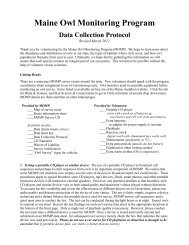Focus Species Forestry - Maine Audubon
Focus Species Forestry - Maine Audubon
Focus Species Forestry - Maine Audubon
You also want an ePaper? Increase the reach of your titles
YUMPU automatically turns print PDFs into web optimized ePapers that Google loves.
Fisher<br />
Distribution: Southeast Alaska to<br />
Newfoundland, south to central<br />
Connecticut, Minnesota, and the<br />
mountains of Colorado and California;<br />
expanding to Pennsylvania and West<br />
Virginia where reintroduced<br />
<strong>Maine</strong> <strong>Focus</strong> Region: South<br />
Home Range: 6-20 sq. mi. (4,000-13,000<br />
acres)<br />
Food: Snowshoe hare, cottontail rabbit, porcupine, squirrels and other small mammals, birds, berries, and other<br />
fruits<br />
Special Habitat Needs: Generally associated with mature conifer and mixed forests, but found in a variety of<br />
forest types and age classes. Dens in hollow trees, logs, or under boulders.<br />
Management:<br />
Maintain landscapes with extensive forests. In developing areas maintain a network of woodlots and<br />
interconnected travel corridors. See landscape recommendations (Section 8).<br />
Maintain dead trees, logs, and other structural features as denning sites and cover for small mammals that<br />
are the fisher’s staple diet.<br />
Create small openings to enhance vegetation diversity and prey abundance.<br />
Maintain or enhance softwood inclusions, including softwood understory cover.<br />
See management guide for snags, cavity trees, and downed woody material (Section 7).<br />
Comments: Landscapes that support fisher are used by a wide variety of forest wildlife. Family forests are<br />
important to the survival of this large member of the weasel family in southwestern and central <strong>Maine</strong>. Mature<br />
conifers are important in northern <strong>Maine</strong> where deep snow limits fisher populations. The fisher has been expanding<br />
southward into eastern Massachusetts and Connecticut, suggesting that it can tolerate human settlement if<br />
interconnected forests are available.<br />
Habitat Use:<br />
Aspen-Birch<br />
Forest Ecosystems<br />
Northern<br />
Hardwoods Oak-Pine Hemlock Spruce-Fir<br />
N. White<br />
Cedar<br />
R S I M R S I M L R S I M L I M L R S I M L I M L<br />
Special-value<br />
Habitats<br />
Riparian/<br />
Wetland Vernal<br />
Forest Pool<br />
R Regeneration and seedlings Mx Mixed conifer-deciduous <strong>Focus</strong> habitat<br />
S Saplings and small poles U Understory present Other habitat<br />
I Intermediate-aged forest C Cavity tree or snag Little/no use<br />
M Mature forest<br />
L Late-successional forest<br />
References: Burt 1976, DeGraaf and Yamasaki 2001, Snyder undated, Krohn 2004<br />
40<br />
<strong>Focus</strong> <strong>Species</strong> <strong>Forestry</strong>


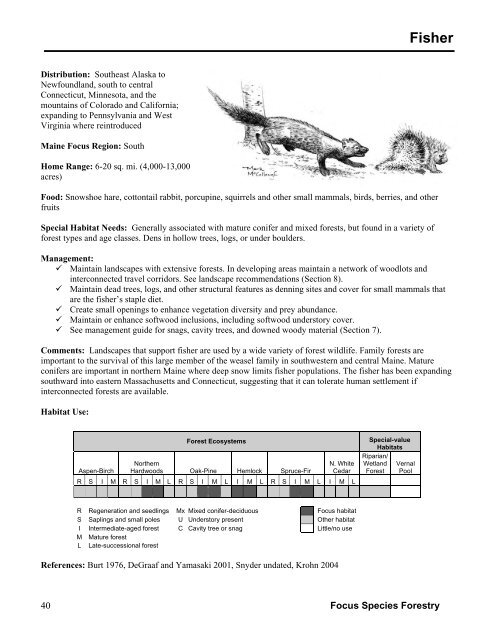
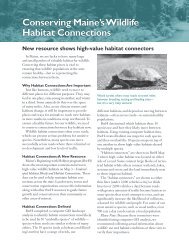
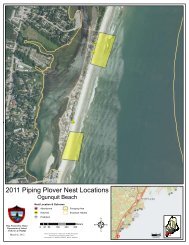
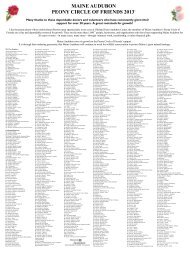
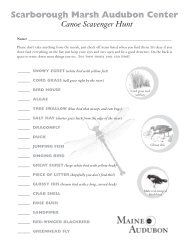


![2012 Loon Count Results [pdf] - Maine Audubon](https://img.yumpu.com/26228732/1/190x245/2012-loon-count-results-pdf-maine-audubon.jpg?quality=85)
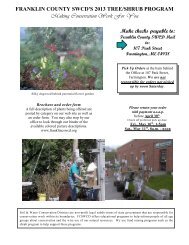
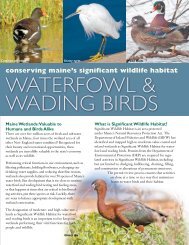
![Lake Fish of Maine (DIFW list) [pdf] - Maine Audubon](https://img.yumpu.com/23282964/1/190x245/lake-fish-of-maine-difw-list-pdf-maine-audubon.jpg?quality=85)
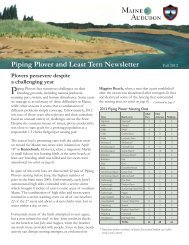

![The Maine Audubon Peony Circle of Friends 2012 [pdf]](https://img.yumpu.com/22707677/1/190x253/the-maine-audubon-peony-circle-of-friends-2012-pdf.jpg?quality=85)
